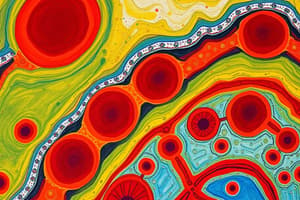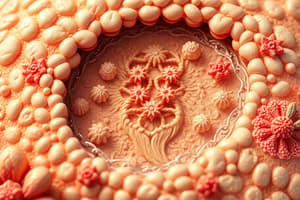Podcast
Questions and Answers
A callus develops when there is constant rubbing or pressure on the skin.
A callus develops when there is constant rubbing or pressure on the skin.
True (A)
Blisters filled with fluid should always be broken to prevent infection.
Blisters filled with fluid should always be broken to prevent infection.
False (B)
The ends of your nails consist of live cells.
The ends of your nails consist of live cells.
False (B)
Hair serves as a protective mechanism for the body against various environmental factors.
Hair serves as a protective mechanism for the body against various environmental factors.
The epidermis is thicker in areas that experience more pressure.
The epidermis is thicker in areas that experience more pressure.
The whitish, half-moon area at the base of a nail is called the matrix.
The whitish, half-moon area at the base of a nail is called the matrix.
Washing the skin around a blister with cold water is recommended for infection prevention.
Washing the skin around a blister with cold water is recommended for infection prevention.
The hair follicle contains live cells that help in hair growth.
The hair follicle contains live cells that help in hair growth.
The epidermis contains blood vessels and is the thinnest layer of skin.
The epidermis contains blood vessels and is the thinnest layer of skin.
Skin regulates body temperature and helps remove wastes.
Skin regulates body temperature and helps remove wastes.
New skin cells are produced to replace dead cells, which helps in wound healing.
New skin cells are produced to replace dead cells, which helps in wound healing.
The outer skin layer protects the body from pathogens and injury.
The outer skin layer protects the body from pathogens and injury.
The skin on your eyelid is thicker than the skin on your palm.
The skin on your eyelid is thicker than the skin on your palm.
The skin is made up of uniform cells in terms of thickness across the entire body.
The skin is made up of uniform cells in terms of thickness across the entire body.
Vitamin D is produced by the skin, helping to maintain bone health.
Vitamin D is produced by the skin, helping to maintain bone health.
If cut or burned, the skin does not regenerate and remain vulnerable.
If cut or burned, the skin does not regenerate and remain vulnerable.
The dermis contains connective tissue and blood vessels that supply nutrients to the skin.
The dermis contains connective tissue and blood vessels that supply nutrients to the skin.
Melanin in the skin provides less protection against ultraviolet rays in darker-skinned individuals.
Melanin in the skin provides less protection against ultraviolet rays in darker-skinned individuals.
Albinos lack pigment in their skin, eyes, and hair, making them more susceptible to sun damage.
Albinos lack pigment in their skin, eyes, and hair, making them more susceptible to sun damage.
The epidermis is primarily responsible for carrying blood and oxygen to skin cells.
The epidermis is primarily responsible for carrying blood and oxygen to skin cells.
Skin has the ability to heal itself when the dermis is cut, resulting in bleeding and pain.
Skin has the ability to heal itself when the dermis is cut, resulting in bleeding and pain.
People with lighter skin produce more melanin than those with darker skin.
People with lighter skin produce more melanin than those with darker skin.
Tanning of the skin occurs only in individuals with dark skin.
Tanning of the skin occurs only in individuals with dark skin.
The function of the epidermis includes protection from environmental damage.
The function of the epidermis includes protection from environmental damage.
Flashcards are hidden until you start studying
Study Notes
Epidermis
- The epidermis is the outermost layer of skin.
- It is made up of 12-15 layers of cells.
- The lower cells are alive and produce new cells, pushing old cells towards the surface.
- As the cells move towards the surface, they become flatter and drier, eventually becoming dead cells.
- The thickness of the epidermis varies depending on the area of the body.
- The palms of hands and soles of feet have thicker epidermis due to constant wear and tear.
- The epidermis contains no blood vessels.
- A callus is an extra thick layer of epidermis that develops due to constant rubbing or pressure.
- A blister is a fluid-filled raised part of the epidermis caused by excessive rubbing or pressure.
Melanin
- Melanin is a pigment responsible for skin color.
- Melanin protects the skin from harmful ultraviolet rays from the sun.
- People living closer to the equator have more melanin due to higher exposure to sunlight.
- Lighter skin tones have less melanin, as their ancestors lived in areas with less direct sunlight.
- Albinos lack melanin completely, requiring careful protection from the sun.
Dermis
- The dermis lies beneath the epidermis and is responsible for many skin functions.
- It contains connective tissue, blood vessels, nerve endings, hair follicles, oil glands, and sweat glands.
- Connective tissue provides elasticity and strength to the skin, attaching it to muscles.
- Blood vessels in the dermis supply food and oxygen to new skin cells, and cause bleeding when cut.
- The dermis contains nerve endings, making it sensitive to pain.
Skin Functions
- The skin regulates body temperature.
- It protects the body from injury and foreign pathogens (germs).
- It helps heal cuts.
- It helps remove waste products from the body.
- It stores water and excess energy.
- It produces vitamin D.
Hair and Nails
- Hair and nails are also part of the epidermis.
- Nails protect the fingertips and toes.
- New nail cells grow from the root, pushing old cells outward to form the nail.
- The ends of nails are made of dead cells, so trimming them does not cause pain.
- Hair protects the body from heat, cold, and excessive sun.
- Eyebrows keep perspiration out of the eyes.
- Eyelashes prevent dust and dirt from entering the eyes.
- The root of each hair contains live cells that produce new hair cells.
- Old hair cells are pushed towards the surface and die, forming the hair we see.
Studying That Suits You
Use AI to generate personalized quizzes and flashcards to suit your learning preferences.




